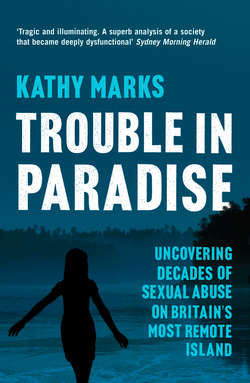Читать книгу Trouble in Paradise: Uncovering the Dark Secrets of Britain’s Most Remote Island - Kathy Marks - Страница 10
Prologue
ОглавлениеPitcairn Island, a British outpost floating in a remote corner of the South Pacific, was until recently considered a tropical paradise. Seldom visited, it is a place of extreme isolation, with no airstrip and limited sea access. The rocky outcrop is inhabited by about 50 people, most of them descended from Fletcher Christian and his fellow Bounty mutineers.
The sailors fled to the island to evade British law, but for the next two centuries Pitcairn was, to all appearances, trouble-free—stabilised by religion, with negligible crime, and largely capable of running its own affairs. Just before the dawn of the new millennium, that perception was turned on its head.
In December 1999 several Pitcairn girls claimed that they had been sexually assaulted by a visiting New Zealander. By chance, a British policewoman was on the island, and one of the girls confided that she had also been raped by two local men in the past. An investigation into those allegations developed into a major inquiry that saw British detectives criss-cross the globe, interviewing dozens of Pitcairn women. Their conclusion was that nearly every girl growing up on the island in the last 40 years had been abused, and nearly every man had been an offender.
I first read about the investigation—codenamed, quite coincidentally, Operation Unique—in 2000, when snippets surfaced in the British and New Zealand media. At that time I was a relative newcomer to Sydney, where I am based as Asia – Pacific Correspondent for The Independent. The story had immediate appeal, combining Pitcairn’s mutinous history with a glimpse of life darkly played out on a far-flung island—an island that also happened to be a British colony, one of the final vestiges of Empire.
What struck me, even at that early stage, was that sexual abuse seemed to have been part of the fabric of life on Pitcairn. I tried to visualise what childhood must have been like for the victims, living there with no means of escape from their alleged assailants.
At the same time, certain Pitcairners—including women on the island—were loudly denying that children had ever been mistreated. They claimed that Pitcairn was a laid-back Polynesian society where girls matured early and were willing sexual partners. Britain, they claimed, was trying to cripple the community and force it to close, thus ridding itself of a costly burden. Who was telling the truth, I wondered: the women describing their experiences of abuse, or those portraying the affair as a British conspiracy?
For Britain, the case raised embarrassing questions about its supervision of the colony, now known as an Overseas Territory. Confronted with such serious allegations, however, the government had no choice but to act robustly. Judges and lawyers were appointed, and in 2003, after a series of legal and logistical hurdles had been surmounted, 13 men were charged with 96 offences dating back to the 1960s.
The plan was to conduct two sets of trials: the first on Pitcairn, the second in New Zealand. Preparations got under way on the island, where the accused men helped to build their own prison. The locals wanted the press excluded; as a compromise, and to prevent the place from being swamped, Britain decided to accredit just six journalists. Media organisations around the world were invited to make a pitch.
On holiday in Japan at the time, I submitted a rather hurried application, pointing out my long-standing interest in the story. I also mentioned that I would be able to file for The Independent’s sister paper, the New Zealand Herald. Shortly afterwards, I was informed that I had been chosen as a member of the media pool.
In 2004 I spent six weeks on the island, reporting on one of the most bizarre court cases imaginable. Outside court, I bumped into the main protagonists every day, which was inevitable, since I was living in the middle of their tiny community. Some of those encounters were civil; others were less so, but I was able to observe at close quarters how Pitcairn functioned: the gossip, the feuding, the claustrophobic intimacy—and the power dynamics that had allowed the abuse to flourish.
The legal saga did not end with the verdicts and sentences handed down on the island by visiting judges. It continued until late 2007, with further trials held in Auckland and the offenders appealing to every court up to the Privy Council in London. As I followed these twists and turns in both hemispheres, my mind buzzed with unanswered questions.
Why was it that many outsiders persisted in defending men who were guilty of a crime that was normally reviled: paedophilia? Why did they continue to mythologise Pitcairn, although it had failed, in such a dramatic way, to live up to its Utopian image? How far back, I asked myself, did the sexual abuse stretch—to the time of the mutineers? Why had parents not denounced the perpetrators and kept their children safe? Had anyone outside the island realised what was going on?
There were bigger questions, too. What did Pitcairn tell us about human nature and life in small, remote communities? Is this how all of us would behave if left to ourselves, with no one looking over our shoulder?
Is Pitcairn a cautionary tale—a real-life version of Lord of the Flies, that chilling story of a group of schoolboys who descend into savagery on an imaginary island?
Are there more Pitcairns out there?
